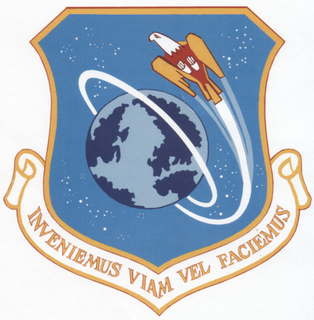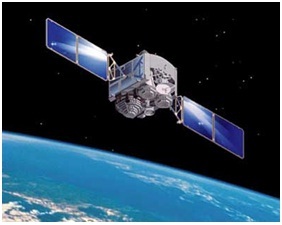
Air Force Space Command (AFSPC) is a major command of the United States Air Force, with its headquarters at Peterson Air Force Base, Colorado. AFSPC supports U.S. military operations worldwide through the use of many different types of space operations. Operationally, AFSPC is an Air Force major command subordinate to U.S. Strategic Command (USSTRATCOM), a unified combatant command. As of 2019 it is the primary space force for the U.S. Armed Forces.

The United States Air Force's Air Force Satellite Control Facility (AFSCF) was a space command and control unit located at Onizuka AFB, California. It has the distinction of being heavily involved in the world's first reconnaissance satellite program, CORONA. Due to geological hazards, and the terrorism threat from its proximity to a major transportation link, the facility's command and control functions were moved to Schriever AFB, Colorado.

Schriever Air Force Base is a base of the United States Air Force located approximately 10 miles east of Peterson Air Force Base near Colorado Springs in El Paso County, Colorado, United States.

The 2d Space Operations Squadron is a unit of the United States Air Force at Schriever Air Force Base, Colorado. Its mission is to manage the Navstar Global Positioning System satellite constellation for global navigation, time transfer, and nuclear detonation detection.

The 2d Space Wing was a wing of the United States Air Force. It activated on 8 July 1985 as the host wing at Falcon Air Force Station. The wing took operational control of the Air Force Satellite Control Network in October 1987. It was inactivated on 30 January 1992 when the 50th Space Wing took its place.

The 850th Space Communications Squadron is an inactive United States Air Force unit. It was a component of the 50th Network Operations Group, 50th Space Wing, Schriever Air Force Base, Colorado. The squadron was activated 1 December 1997 as the 850th Communications Squadron and redesignated the 850th Space Communications Squadron on 1 October 2002. It was inactivated on 31 January 2006, most of its functions and personnel having been incorporated into the 50th Space Communications Squadron.

The 6th Space Operations Squadron is an Air Force Reserve satellite command and control squadron located at Schriever Air Force Base, Colorado. The squadron is a backup to NOAA for Defense Meteorological Satellite Program operations.

The 21st Space Operations Squadron is a satellite control unit of the 50th Network Operations Group of the United States Air Force located at Vandenberg Air Force Base, California. It operated Onizuka Air Force Station from its formation in 1991 until the closure of the station in 2010.

The United States Air Force's 3d Space Operations Squadron was a satellite operations unit located at Schriever Air Force Base, Colorado.

The United States Air Force's 5th Expeditionary Space Operations Squadron is an expeditionary satellite operations unit, assigned to Air Force Space Command to activate or inactivate as needed.

The United States Air Force's 148th Space Operations Squadron is a satellite control unit located at Vandenberg AFB, California. The 148th SOPS is tasked with back-up command and control of the MILSTAR satellite constellation.

The United States Air Force's 18th Space Control Squadron is a space control unit located at Vandenberg AFB, California. Reactivated in 2016, the 18th SPCS is tasked with providing 24/7 support to the space sensor network (SSN), maintaining the space catalog and managing United States Strategic Command’s (USSTRATCOM) space situational awareness (SSA) sharing program to United States, foreign government, and commercial entities. The squadron also conducts advanced analysis, sensor optimization, conjunction assessment, human spaceflight support, reentry/break-up assessment, and launch analysis.

The 19th Space Operations Squadron is an Air Force Reserve space operations unit, located at Schriever Air Force Base, Colorado.

The 17th Test Squadron is a United States Air Force test and evaluation unit, located at Schriever Air Force Base, Colorado. The squadron is tasked with testing and evaluating space systems and associated support equipment.

The 55th Weather Reconnaissance Squadron is an inactive United States Air Force unit. It was last assigned to the 50th Operations Group at Schriever Air Force Base, Colorado, where it was inactivated on 16 July 2002.

The 14th Test Squadron is a United States Air Force unit located at Schriever Air Force Base, Colorado. It is an Air Force Reserve unit that augments the 17th Test Squadron. The squadron is responsible for testing and evaluating space systems and associated support equipment. The unit was originally established in 1972 as the 14th Missile Warning Squadron. The missile warning squadron was an active duty unit that operated early warning radars at eight locations around the United States until it was inactivated in 1980. The squadron was reactivated and given its current space test mission in 2000.

























